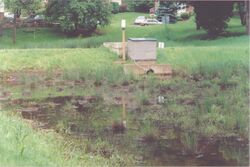Engineering:Media filter

A media filter is a type of filter that uses a bed of sand, peat, shredded tires, foam, crushed glass, geo-textile fabric, anthracite, crushed granite or other material to filter water for drinking, swimming pools, aquaculture, irrigation, stormwater management, oil and gas operations, and other applications.
Each layer of media is designed to filter out specific types and sizes of particles, allowing for more efficient and effective removal of contaminants.
Design
One design brings the water in the top of a container through a "header" which distributes the water evenly. The filter "media" start with fine sand on the top and then becomes gradually coarser sand in a number of layers followed by gravel on the bottom, in gradually larger sizes. The top sand physically removes particles from the water. The job of the subsequent layers is to support the finer layer above and provide efficient drainage.
As particles become trapped in the media, the differential pressure across the bed increases. Periodically, a backwash may be initiated to remove the solids trapped in the bed. During backwash, flow is directed in the opposite direction from normal flow. In multi-media filters, the layers in the media re-stratify due to density differences prior to resuming normal filtration. Multimedia filter can remove particles down to 10-25 microns.
Advantages and disadvantages
Advantages of multimedia filters
- Multimedia filters use multiple layers of different filter media to achieve more effective and efficient filtration than single-media filters like sand filters.
- They can remove a wider range of particle sizes and types than single-media filters, resulting in more efficient filtration and longer filter life.
- They are effective at removing suspended solids, turbidity, and other contaminants from water.
- They can be used for a wide range of flow rates and particle sizes. They can be easily backwashed to clean the filter media and restore filtration efficiency.
- They require little to no electricity to operate.
Disadvantages of multimedia filters
- Multimedia filters have a higher capital cost compared to single-media filters like sand filters.
- They have a larger footprint and require more space than single-media filters.
- They may not be effective at removing some types of contaminants, such as dissolved organic compounds and bacteria.
- They may require pre-treatment to remove large particles or debris that could clog the filter media.
- They can create waste material (backwash water) that needs to be treated or disposed of properly.
Uses
Drinking water
Media filters are used in drinking water treatment, where multimedia filters are used as a primary or secondary filtration step to remove a wider range of particle sizes and types than sand filters, including organic matter and smaller particles.
Municipal drinking water systems often use a rapid sand filter and/or a slow sand filter for purification. Silica sand is the most widely used medium in such filters.[1] Anthracite coal, garnet sand, ilmenite, granular activated carbon, manganese green sand and crushed recycled glass are among the alternative filter media used.[2]
Stormwater

Media filters are used to protect water quality in streams, rivers, and lakes. They can be effective at removing pollutants in stormwater such as suspended solids and phosphorus. Sand is the most common filter material.[3][4] In other filters, sometimes called "organic filters," wood chips or leaf mold may be used.[5]
Sewage and wastewater
Media filters are also used for cleaning the effluent from septic tanks and primary settlement tanks. The materials commonly used are sand, peat and natural stone fibre.
Oil and gas industry
The oil and gas industry uses media filters for various purposes in both upstream and downstream operations. Nut shell filters are commonly used as a tertiary oil removal step for treatment of produced water. Sand filters are often used to remove fine solids following biological treatment and clarification of oil refinery wastewater. Multi-media filters are used for removing suspended solids from both produced water and refinery wastewater. The materials commonly used in multi-media filters are gravel, sand, garnet, and anthracite.[citation needed]
See also
References
- ↑ American Water Works Association (1999). "Chapter 8". Water Quality and Treatment: A Handbook of Community Water Supplies (5th ed.). New York: McGraw-Hill. ISBN 9780070016590.
- ↑ Soyer, Elif; Akgiray, Ömer; Eldem, Nursen Öz; Saatçı, Ahmet Mete (2013). "On the Use of Crushed Recycled Glass Instead of Silica Sand in Dual‐Media Filters". Clean Soil Air Water 41 (4): 325–33. doi:10.1002/clen.201100470.
- ↑ Water Environment Federation, Alexandria, VA; and American Society of Civil Engineers, Reston, VA. "Urban Runoff Quality Management." WEF Manual of Practice No. 23; ASCE Manual and Report on Engineering Practice No. 87. 1998. ISBN:1-57278-039-8. Chapter 5.
- ↑ Atlanta Regional Commission. Atlanta, GA."Georgia Stormwater Management Manual." Section 3.2.4: "Sand Filters." August 2001.
- ↑ ibid., Section 3.3.3: "Organic Filter."
References Nalco Water, an Ecolab Company. Nalco Water Handbook, Fourth Edition (McGraw-Hill Education: New York, Chicago, San Francisco, Athens, London, Madrid, Mexico City, Milan, New Delhi, Singapore, Sydney, Toronto, 2018). https://www.accessengineeringlibrary.com/content/book/9781259860973
 |

